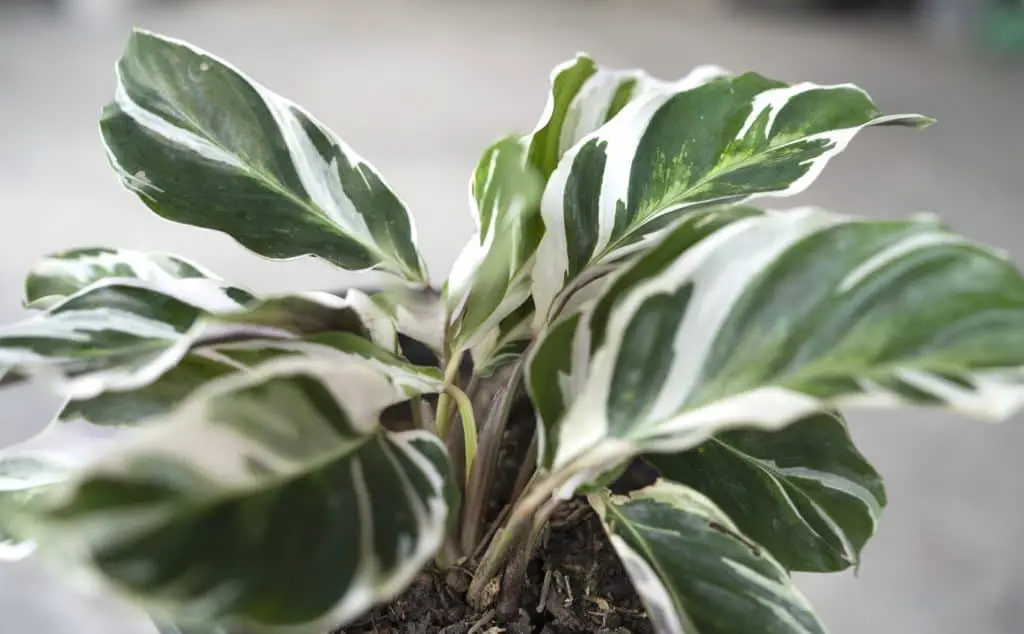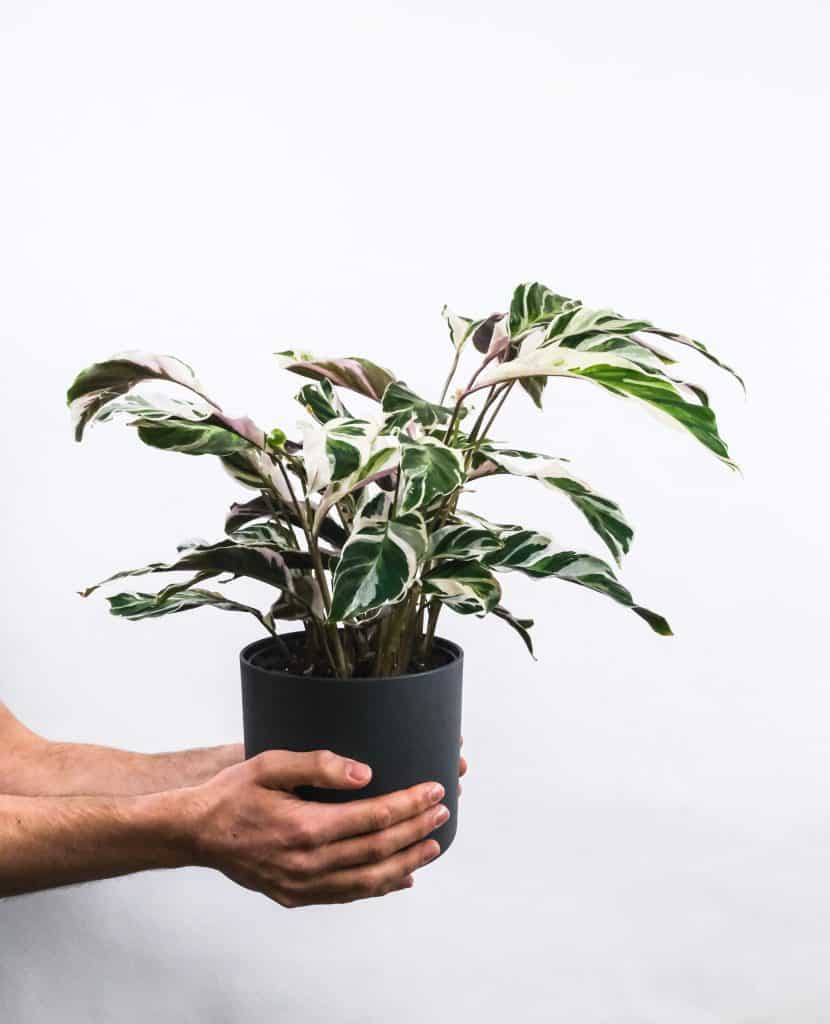Are you looking for a gorgeous, tropical houseplant with bold markings that makes any room pop? Well, look no further than the calathea fusion white (calathea lietzei). The calathea fusion white goes by names like peacock, zebra, or rattlesnake plants because of its unique markings and decorative colors. It is native to central Mexico all the way to tropical South America regions. The reasons it gets its name calathea fusion white is because it has a green leaf with contrasting white markings on them, which make them perfect for indoor decoration. The calathea fusion white also has a touch of purple underneath. People often call calathea plants “prayer plants” because of its habit of folding the leaves up at night, which make them look like their hands are praying. Interestingly, the calathea fusion white plant is considered the queen of prayer plants from the family Marantaceae, but also because the plant can be a bit of a drama queen if it does not live in the proper environment.
There are many benefits to having a calathea fusion white in your house. For reason, if you can find the spot for the calathea fusion white, it will become the showpiece of your plant collection due to its unique coloring. Additionally, the calathea fusion white is beneficial because it filters out bad ait and makes any room smelling fresh and clean. Another major benefit is that the calathea fusion white plant is not too difficult to take care of as long as you give it the proper environment and care to thrive in.
Calathea Fusion White Care
The calathea fusion white is a herbaceous perennial and is fairly easy to take care of. Like more calathea plants, it is important to plan accordingly to where your calathea white fusion is going to live. If it is going to be outdoors, then be sure to place in an area that does not get direct sunlight for too long. Plus, you need to take other outside factors into consideration like the year round temperature, rainfall, and soil type. These are much easier to control if you keep the plant indoors. If you are planning on keeping it inside the house, then it is best to keep the sunlight partial and not put it anywhere where it will be exposed to too much light.

Lighting Requirements
This is probably one of the more challenging aspects of the calathea fusion white. When placing your calathea fusion white, it is best to place it somewhere facing north or south. This will avoid too much direct sunlight and give the calathea fusion white a better chance to survive. Too much direct sunlight can damage the plant. Be careful though because if the plant gets poor lighting, then it can cause poor growth. Filtered bright light works best, so make sure you find the perfect spot for your calathea fusion white.
Soil
The soil mixture that is recommended for the calathea fusion white is Africa violets because they retain moisture well and can easily drain any excess water. Making a peaty, airy, lightweight potting mix is not too difficult. You can combine orchard bark, perlite, and any standard potting soil to create the perfect base for you calathea fusion white. The soil should also have an acidic pH level.
Watering
Like most calathea, the calathea fusion white prefers to be consistently moist, but not soggy or waterlogged. Too much water will damage or even kill the plant, while too little water will dry it out and make the leaves curl. Overly wet soils can lead to root rot and other bacterial issues. Therefore, it is important that you water thoroughly, but make sure that the water is draining out of the bottom and does not accumulate in a collection plate. A good rule of thumb is checking the top inch of the soil, if it is dry, then it is time to water the plant. In winter, the calathea fusion white will not require so much water, probably only needing it every two weeks or so. In the summertime, it might need a bit more watering. Checking the plant on a weekly basis is a good way to ensure that the calathea fusion white is getting the water that it needs to survive.
Most botanists and plant enthusiasts will collect rainwater or use distilled water for their calathea fusion white since those waters tend to be safe from unnecessary chemicals. However, if you want to use room temperature water, that is fine too.
Temperature and Humidity
This is another major factor in making sure that the calathea fusion white lives a long life. You need to avoid extreme temperature. While the calathea fusion white tends to favor warmer temperatures, too much heat can dry out the plant and even damage it. Any sudden changes to the temperature can also have a negative effect on the plant. The temperature tolerance of the calathea fusion white is between 65 and 80°F. But again, try not to change the temperature too suddenly.
As for humidity, most calatheas need to have a humid environment in order to thrive. A good humid environment for the calathea fusion white is at least 85%. In order to keep this humidity level high, you could invest in a humidifier and place it near the calathea fusion white. Another option is putting a tray with some pebbles underneath the plant, that way any water that it collects in the pebbles will evaporate and increase the humidity levels without soaking the plant’s roots too much. Whichever way you choose, try to avoid any direct drafts on the plant, but have a nice balance by providing some decent ventilation. The hardiness zone of the calathea fusion white plant is between 11b and 12b according to the USDA.

Fertilization
When fertilizing the calathea fusion white, it is best to use liquid fertilizer during its growth period, which is between spring and fall. Do not feed it during the winter season. A nitrogen-rich fertilizer made for houseplants with dense foliage will work great. Plus, the calathea fusion white does not need a strong dose. An NPK 10-10-10 which is diluted in half once a month should be plenty. An organic fertilizer is preferred and you can buy some commercial products, but you can also make your own quite easily. It really depends on whether or not you have access to compost. If so, then making “compost tea” is a very popular DIY organic fertilizer that can be used on many houseplants. Also important to note that you should never fertilize your plant right after repotting.
Propagation
When your calathea fusion white has grown large enough, it will produce these large clumps which can be separated and grown as new plants. The best time to do this would be in the spring or summer. Water your plant a few days before doing this and remove it gently from the pot. The calathea fusion white has fragile roots so be careful. Divide the plants at the natural separations in the roots and plant them into new pots, adding the same type of soil mix you used before. Keep them warm and moist and give them as much humidity as possible. Soon, you should have some skinny, scrawny looking youngsters that will grow into lush plants, assuming you give them the same care.
Size and Growth
The calathea fusion white is not a very large plant, although it does have some larger leaves than many other houseplants. At its mature size, the calathea fusion white will reach to about two feet tall. The growth rate is a bit harder to determine because of the finicky requirements of the calathea fusion white. Depending on how often you water it, the soil type, temperature, and the humidity, the growth rate can change.
Common Pests and Diseases
Your biggest issue with the calathea fusion white is how much humidity it will need. Therefore, you may experience fungus gnats that can be a problem. While they won’t do any significant damage to the plant, they are unsightly. Simply apply some neem oil to the leaves as a natural deterrent. Some other common pests to watch out for would be aphids, mealybugs, spider mites, and scale. All of these can be treated with horticultural oil or insecticidal soap. Calathea fusion white plants are also prone to bacterial and fungal infections.
If you see the leaves curling and drooping, then it would be best give it more water. Due to the specific needs of the calathea fusion white, curling is a clear indication that the plant needs more water. Increase the volume of water or the frequency in which you are watering it.
If the leaves are turning yellow or have brown edges, there might be too much sun hitting the leaves of the calathea white fusion. Any dead leaves should be removed immediately. You will also need to move the calathea fusion white into a new area since it is getting too much sun. You will also need to do this if the patterns on the leaves are also disappearing.
If your calathea fusion white looks like it is dying, you may need to start over from scratch. Therefore, it is best to make sure you don’t run into any of these problems after you have invested so much time into growing the plant.
Repotting
It would be good for you to repot the calathea fusion white about once a year or two to replenish the soil. When doing this, try to increase the size of the container an inch or two each time. It is best to do this in the spring or early summer during its active growing season. Make sure to water it thoroughly a day or two before repotting to lessen the stress on the plant. If you tend to water too much, use a terra cotta pot that is unglazed. If you are more on the forgetful side, then try a glazed clay, plastic, or fiberglass pot. Replace the soil with some fresh soil and water it nicely.
Blooming
While most calathea bloom in their natural environment in South America and can produce gorgeous flowers, the calathea fusion white grown indoors will not likely bloom. If it does, give yourself a pat on the back because you are doing a fantastic job.
The calathea fusion white will not move very much at night with the exception of the leaves that will curl up ever so slightly to look like it is praying. Otherwise, this plant does not move very much.
Other Facts About Calathea Fusion White
The calathea fusion white is a safe houseplant that is non-toxic. Therefore, it will not harm any people or pets. That being said, people and pets might be toxic to the calathea fusion white. The leaves of the plant are delicate and can easily be damaged. It would be best to keep the plant out of reach of plants and pets, so it can thrive without disturbance.
If you are looking to buy the calathea fusion white, they are available at various shops like Etsy, eBay, Walmart, and Target. These plants will range in price from anywhere from $30-60. You can also buy seeds as well, but it will be more time consuming for you to grow them on your own. However, if you are really trying to get the best advice and quality from your calathea fusion white, it is recommended that you get the plant from a professional flower shop. This way, you can be assured that the calathea fusion white was taken care of before you got it. Furthermore, the professionals running the store will have a lot of advice and knowledge that will help you grow your calathea fusion white in the best way possible. These places tend to have a lot more expertise behind them and can also have more knowledge in how to help you if you run into any kinds of trouble.
